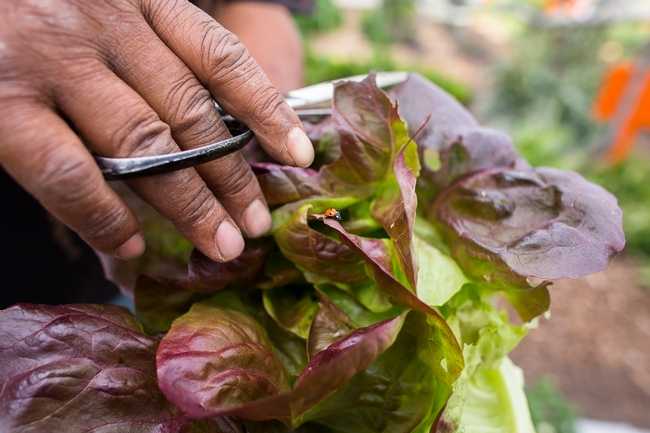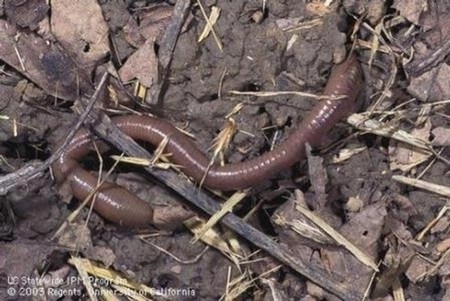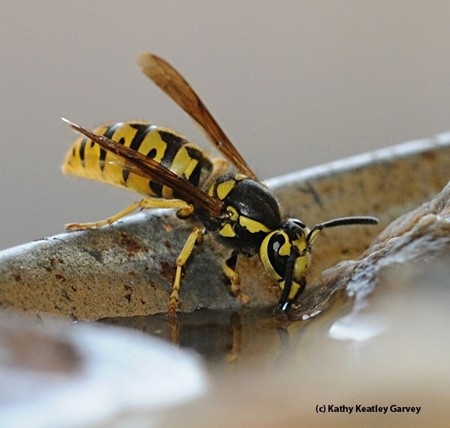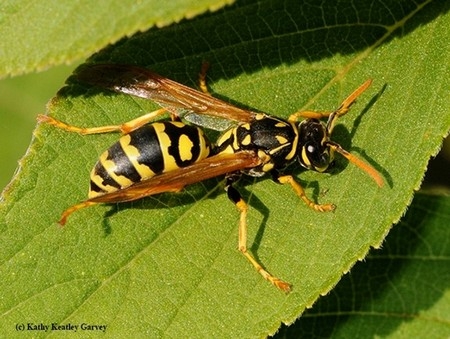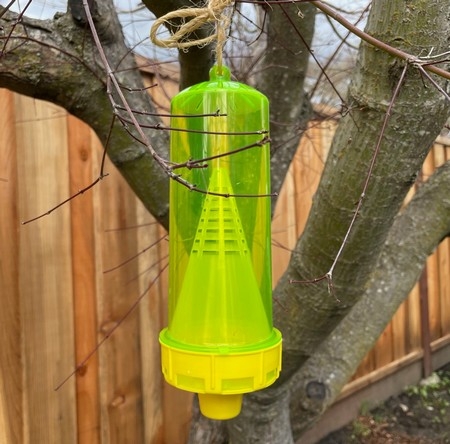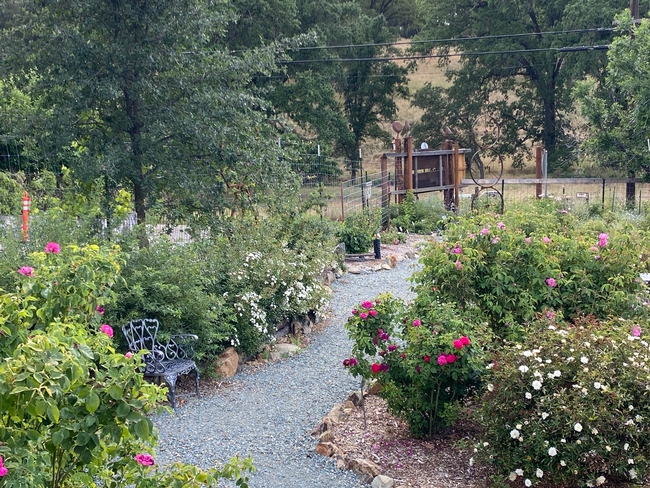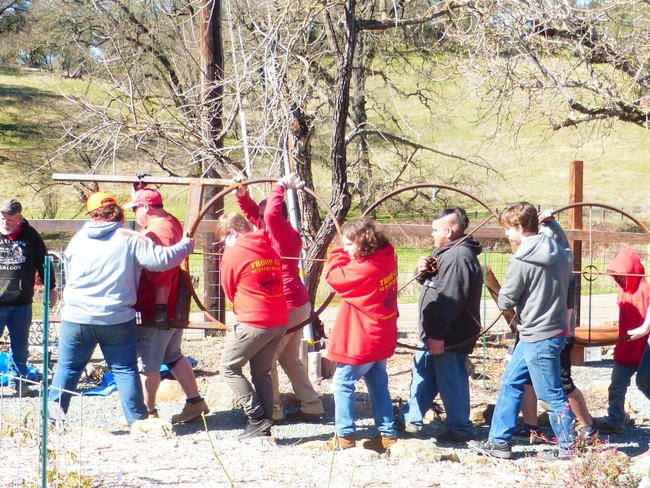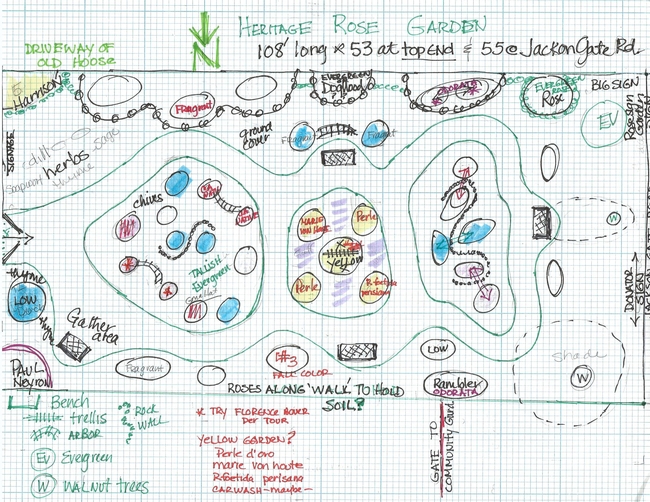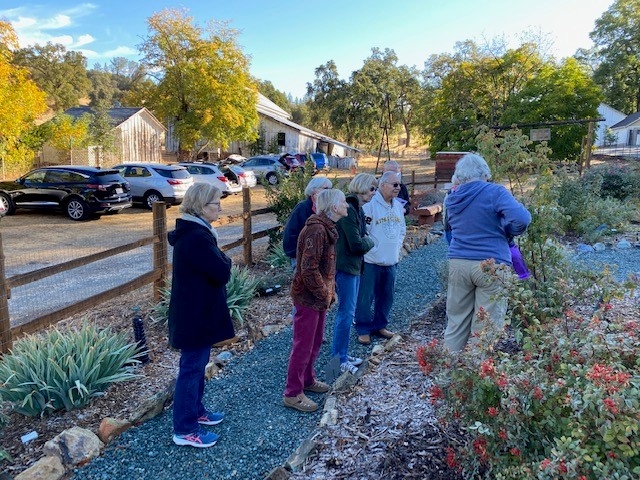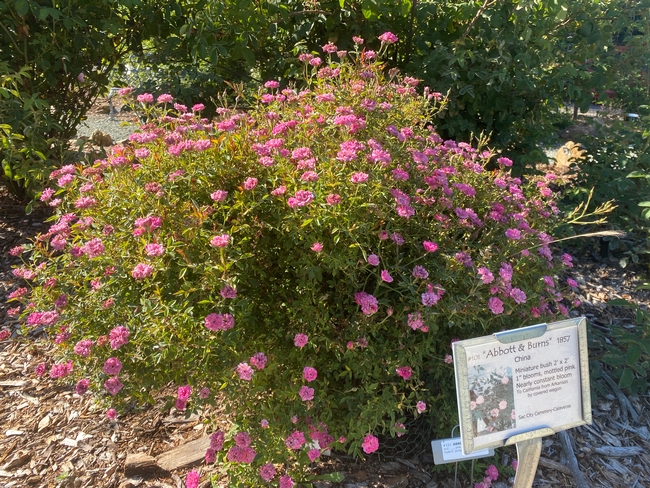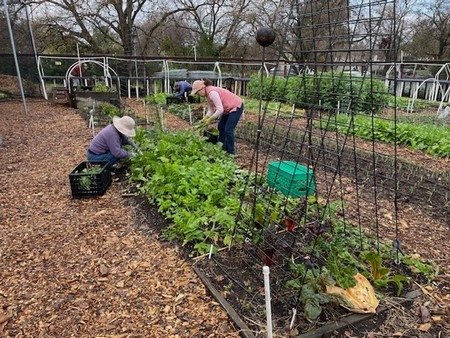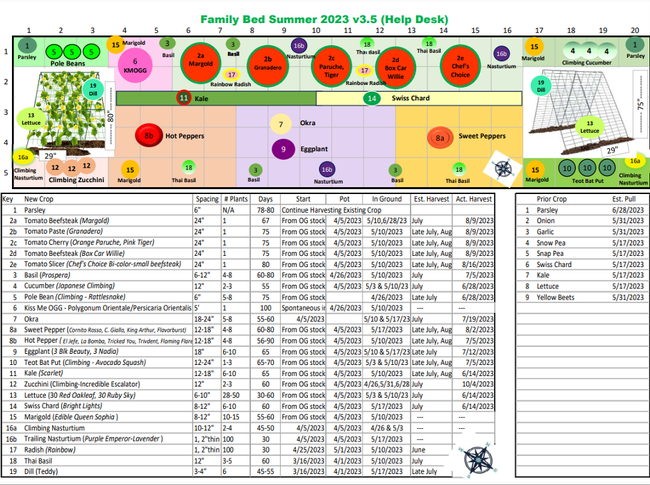From the UC Blogosphere...
Keep your Garden Healthy as it Kicks into High Gear - April Garden Tips
As April unfolds, California gardeners eagerly anticipate the season's lush beauty. With frost receding into memory and temperatures climbing, it's time to welcome a fresh wave of blossoms and produce. Whether you reside in the north, south, or somewhere in between, here's a comprehensive checklist to help guide your April gardening activities:
- Conceal Fading Bulb Foliage. Hide fading bulb foliage with shallow-rooted annuals like lobelia or sweet alyssum. This not only enhances the garden's appearance but also aids in vital nutrient transfer for next year's blooms.
- Monitor Roses. As roses leaf out and bud, monitor them for aphids. If you find aphids, remove them from your plants with a strong stream of water. This practice helps manage populations so you don't end up with a large colony.
- Add Summer Annuals. Brighten flower beds with summer-blooming annuals, enriching the soil with organic compost to support vibrant growth and colorful displays.
- Plant Summer Vegetables. Sow seeds or transplant summer vegetables as the weather gets warmer, ensuring they receive sufficient sunlight and nutrient-rich soil. Hold off on planting tomato starts until nighttime temperatures remain above 55?F to avoid frost damage.
- Pest Control. Safeguard young plants from pests like snails, slugs, and earwigs by using traps. Regular monitoring and intervention help maintain garden health.
- Mulch Application. Apply mulch around trees and in beds to retain soil moisture as temperatures rise. This helps conserve water and provides insulation to plant roots during warmer weather.
- Plant Frost-Tender Species. Introduce frost-tender species appropriate to your growing zone. Ensure regular watering to keep the root zone moist but not waterlogged.
- Care for Citrus and Fruit Trees. Prune frost-damaged branches to promote healthy growth and fruit production. Proper care ensures a bountiful harvest later in the season.
- Weed Management. As weeds pop up after all the Spring rains, employ non-chemical methods like cultivation, handweeding, or mowing to manage weeds effectively. Keeping weeds in check helps maintain the health and aesthetics of your garden beds.
With this April garden checklist, you're well-equipped to embrace the season's abundance and nurture a thriving garden.
Ask your local UC Master Gardener Program
Have a gardening question? UC Master Gardener volunteers are available to help. Click here to Find a Program and connect with your local UC Master Gardener Program. You will be redirected to your local county website and contact information. UC Master Gardener volunteers are available to help answer questions for FREE. Happy gardening!
How Many Earthworms are Enough?
Perhaps you've seen them. You're digging into the soil to plant something and as you dig you run across a few earthworms. Most of us have heard from childhood that worms are good for the soil. You may also be aware of vermiculture, or worm composting, using worms to help turn organic waste into nutrient rich compost for the soil. When you see earthworms in your garden, what does their presence suggest about the soil health? Should you add more?
Earthworms and Wigglers
The earthworms you typically see in your garden are considered "migratory" which means they will travel to find the habitat best suited to their success. They tend to cluster in the top 6 to 8 inches of soil around the roots of plants where they feed on decaying material and the fungi and other organisms that live there. As they travel through the soil, they drag leaves and other litter down into their burrows where soil microorganisms also begin digesting the material. These worms can tolerate colder temperatures through the winter months when they burrow deeper into the soil.
Earthworms need a light airy soil and rely on decaying organic material for nourishment. Introducing these earthworms to an inhospitable environment such as heavy clay, or compacted and/or dry soil, will result in them either leaving or dying. Where they flourish, however, they are important in mixing the dead surface litter with the main body of the soil. If you regularly add compost and a layer of mulch to your garden to improve the soil you may find the worms 'magically' appear, attracted to the habitat you are creating. In turn their constant burrowing and feeding activities help mix and distribute organic matter throughout the soil, improve soil aeration and water penetration, promoting a healthier root environment for your plants. Their excrement, known as castings, is richer in nitrogen, potassium carbon, sulfur, and other minerals than the rest of the soil, and acts as a natural fertilizer.
There is a second type of worm which lives close to the soil surface in areas of abundant organic material. These worms, including the popular species red wigglers, reproduce rapidly and thrive in warm, crowded conditions. They are less likely to survive in your garden environment, particularly during cold weather. Instead, these worms are ideally suited to worm bins, and you will usually find them for sale for use in vermiculture. In a bin they can rapidly break down food scraps and other organic waste materials, and their castings also act as a natural fertilizer when collected and added to garden soils. Think of these worms as composting specialists.
A Note of Caution
There is a type of worm known as a jumping worm, an invasive species capable of harming native forests which has been seen in California and many other states. It is recognizable by a milky-white band wrapping all around its body near the head. When disturbed, jumping worms have been known to throw themselves into the air and thrash around. It is very difficult to eliminate these worms once established, so make sure to check new mulch, compost, and potting soil for the worms, as well as soil in nursery pots. Because they live close to the surface their castings are often visible as a coffee-ground-like substance on the soil. Don't use these worms for fishing, vermiculture, or gardening. You can learn more about jumping worms at https://ucanr.edu/blogs/blogcore/postdetail.cfm?postnum=56929.
The Bottom Line
Should you add worms to your garden soil? Ultimately, it's a chicken and egg situation. Do earthworms create healthy soil or are they attracted to healthy soil? Few valid studies have been done to link the presence of earthworms with improved plant growth. However, both plants and earthworms need temperatures between 60°F and 100°F, water (but not too much or too little), oxygen, and a soil that isn't too acidic, basic, or salty. It's clear the conditions that are good for plants are also good for earthworms, and improving your soil by regularly adding compost and mulch ends up supporting a thriving community of both healthy plants and earthworms.
Help Desk of the UC Master Gardeners of Contra Costa County (RDH)
Yellowjackets
Were you bothered by yellowjackets last summer? Now is the time to get traps baited and placed outdoors. Overwintering western yellowjacket queens have been dormant all winter and are emerging now that spring is here, to feed and start a new nest. If you can capture the queen, you can prevent a new colony from forming.
There are two kinds of social wasps in our area that look somewhat alike—yellowjackets and paper wasps. Yellowjackets are the more problematic ones because their colonies can be much larger—there can be several thousand or up to fifteen thousand—and they vigorously defend their nests when disturbed. Their nests are usually underground in rodent burrows. These are the wasps that visit picnics and barbecues to scavenge meat and sugary foods.
Paper wasps are less defensive and rarely sting people. They build their paper nests in protected areas such as under house eaves. They can be a problem when the nest is over a doorway. The population in a nest is seldom over 100 wasps and is commonly only one or two dozen wasps.
Both yellowjackets and paper wasps provide a beneficial service by eating large numbers of pest insects. It is later in the summer when their colonies have grown larger and need more and more food that yellowjackets become scavengers, looking for whatever protein or sugar sources they can find. At this point, it is almost impossible to control their population. This is why it's so important to start the control process before you start to see yellowjackets flying around your picnic.
You can purchase yellowjacket traps at hardware stores or nurseries. These yellow plastic traps have a chemical attractant that lures yellowjackets into the trap. Follow package directions carefully. Make sure you don't get the attractant on your hands when you are setting it up to avoid attracting yellowjackets to your hands.
What to do if you find a nest on your property? Contra Costa Mosquito and Vector Control will treat ground-nesting yellowjackets at no charge. Contact them at 925-685-9301 or https://www.contracostamosquito.com/request-services For above-ground nests, you should call a licensed pest control company.
For more information on controlling yellowjackets and other social wasps, see this link: https://ipm.ucanr.edu/PMG/PESTNOTES/pn7450.html
Quick Tips: https://ipm.ucanr.edu/QT/yellowjacketscard.html
Help Desk of the UC Master Gardeners of Contra Costa County (SEH)
Cultivating History and Community with The Heritage Rose Garden of Jackson, California
Cultivating History and Community with the Heritage Rose Garden of Jackson, California
Nestled in the heart of Amador County lies the Heritage Rose Garden, where the beauty of old roses meets the spirit of community. Here, UC Master Gardener volunteers have been hard at work, not only preserving the past but also teaching sustainable gardening practices to visitors from all walks of life.
The Heritage Rose Garden's story began with a mission to save a precious collection of heritage roses. Judy and Bob Dean, with their extensive collection of rare roses, narrowly escaped destruction during the Butte fire of 2015. Recognizing the need to protect these treasures, Bob Dean proposed the idea of creating a "backup" garden accessible to the public. This vision sparked a partnership between the UC Master Gardener Program and Mother Lode Land Trust (MLLT), aligning with their mission to preserve wildlife habitat and agriculture. Together, they laid the groundwork for a collaborative effort that blossomed into the Heritage Rose Garden located in Jackson, Calif. By 2023, the Heritage Rose Garden inspired continued partnership on the property with the completion of a propagation house, vegetable garden beds, fruit trees and compost education station. All of these new developments serve as a teaching space for the community. The Master Gardeners partnered in 2023 with Amador County Library to teach monthly hands-on, all-age workshops in this newly created space which is adjacent to the Heritage Rose Garden.
Guided by UC Cooperative Extension (UCCE) environmental horticulture advisors, UC Master Gardeners meticulously designed the garden, incorporating integrated pest management (IPM) principles to create a sustainable, pesticide-free landscape. Today, the Heritage Rose Garden boasts not only a diverse collection of heritage roses but also native plants, and thriving pollinators, all flourishing under their stewardship.
However, the Heritage Rose Garden's significance extends far beyond its botanical beauty. It serves as a testament to the power of community collaboration, with UC Master Gardeners partnering closely with local gardening clubs, rose societies, nurseries, and youth groups to cultivate a shared sense of stewardship for the land. Situated within the community of Jackson, the Heritage Rose Garden serves as a welcoming gathering place for residents of Amador County and visitors alike.
Education is at the heart of the Heritage Rose Garden's mission. Through a wide array of classes, workshops, demonstrations, and open garden days, UC Master Gardeners have significantly expanded outreach, welcoming more than 800 visitors a year. Volunteers have logged thousands of hours, contributing to the garden's success and impact. The unique mix of old roses, natives, and heirloom plants showcases what visitors can achieve in their own gardens. Public education classes show tangible results, with more than 80% reporting improved “right plant, right place” and water conservation practices. The Heritage Rose Garden serves as a living classroom, demonstrating the benefits of sustainable gardening practices and inspiring visitors to create their own thriving gardens.
As visitors wander through the Heritage Rose Garden's winding pathways, they encounter a tapestry of history, community, and natural beauty. With each rose in bloom and each lesson shared, UC Master Gardeners are not only preserving the past but also sowing the seeds for a more sustainable and connected future.
To learn more about the Heritage Rose Garden or to plan a visit please visit: ucanr.edu/sites/Amador_County_MGs/Heritage_Rose_Garden/
Creating a Family Garden Bed
Most of us in urban and suburban areas don't have enough room for a large edible garden. Our space is limited for growing vegetables, so we need to try different techniques to maximize our yields.
The Family Garden Bed at Our Garden demonstration garden in Walnut Creek is a tangible example of what a family can accomplish when planting vegetables in their own backyard. Over the past couple of years, our 5'x20' plot has yielded roughly 500 pounds of produce each year.
Our Family Garden Bed was created 6 years ago when our garden team decided to dedicate one of our 30 existing garden plots to create and demonstrate what a family can accomplish in a small space in their own backyard. The plans for the bed evolved into a square-foot gardening concept resulting in greater vegetable yields.
Our most successful and prolific vegetable plantings are sweet potatoes, squash, onions, and tomatoes, so we plant these vegetables every year. However, we are not planning to plant sweet potatoes this season to make room for other experimental vegetables.
We have had a few failures. For example, one year we experimented with corn which took up a full square yard of space in the bed. Unfortunately, the corn provided a surprisingly low yield for our efforts. Because corn takes up a lot of space, requires a lot of water, and robs the soil of nitrogen, we no longer grow it.
The family bed continues to evolve with enhanced emphasis on edible greens that produce quite nicely during the colder months. We now have an antioxidant section featuring beets and leafy greens such as kale and spinach. We also have an “Asian” greens section featuring tatsoi and bok choy.
With the approach of spring, our Family Garden Bed Team has started to propagate seeds for the coming growing season. We plant one seed for lettuce, bok choy, tatsoi, and kale per cell in plastic six packs to get started. These seedlings will be planted in the ground in 4 to 6 weeks. Once these plants get growing, we propagate tomatoes, squash, melons, cucumbers, and other summer crops. All this is according to the master plan set down on a color-coded excel file that directs our weekly adventures.
Here is an example of our color-coded file:
OR
Here are some tips for getting the most out of every inch of space in your own Family Garden:
• Location, Location, Location: Summer crops, such as tomatoes, squash, beans, melons, and peppers all need at least 6 hours of full sun daily. A garden bed is best placed lengthwise east to west to take advantage of the sun throughout the day. Plant taller plants so they do not shade shorter plants.
• Soil and Water: Amend your soil so that you end up with what would be described as a loamy texture. Use a good compost (your own if possible), and organic fertilizers which will help build a healthy soil environment for plants over the long haul. How often you water will depend on the time of year, rainfall, how the soil retains water, the needs of your vegetables and how deep their roots grow.
• Trellising: You can maximize your bed space by trellising tomatoes, pole beans, cucumber, squash, and melons. This technique can provide shade for the lettuces that will produce longer if protected from direct summer sun.
Planning and Tracking
• Create garden plans for both warm weather and cool weather. We suggest starting small and experimenting.
• Select vegetable crops, based on what your family likes to eat, adding in something fun or new each year.
• Research and document vegetable requirements on seed packages or plant tags:
• Look up plant spacing, Days to Maturity/When to harvest, Start date to seed or plant.
• After you figure out vegetables to plant, then determine the number of plants required for your space. Since the Family Bed is 5' x 20', mini beds are designated, usually 3'x3' or 4'x4', or any configuration that will work for each vegetable. Have fun by creating a focus, such as a salsa bed, pizza bed, salad bed, antioxidant bed, etc.
Bed Layout — Getting the most out of each inch of space
• Intensive planting using the triangulation method. Place a plant at each corner of an equilateral triangle, where the length of a side is the plant spacing requirement. For example, you can plant 5 instead of 4 cabbage heads or broccoli in a 3'x3' plot.
• Intercrop planting: Mix in smaller faster-growing vegetables such as lettuce, spinach, radishes between larger, slower-growing crops such as broccoli, cabbage, cauliflower. For warm weather vegetables, plant lettuce, radishes, basil, etc., between tomato plants.
• Multi-vining tomato plants (2 to 4 vines) to get more variety of tomatoes in a bed.
• Trellising / Vertical planting: Plant upwards: indeterminate tomatoes, squash, melons, cucumbers, etc. Plant smaller, fast-growing plants under the trellis. This technique can provide shade for lettuces that will produce longer if protected from direct summer sun.
• Fill in blank spots by adding edible flowers for beauty and pollination.
Our Family Garden Bed has been a work in progress, and we learn new things every year much to our surprise! We highly recommend keeping track of what you plant each season to help you make plans for the future.
For more tips on successful gardening, check out the Edible and Sustainable gardening resources on our website: https://ccmg.ucanr.edu/
And please visit the Family Bed at our demonstration garden this spring! Our Garden is located at the southwest corner of North Wiget Lane and Shadelands Drive, just north of Ygnacio Valley Road, in Walnut Creek. We're normally open to the public from 9:00 am to noon on Wednesdays April through October.
Hope to see you at Our Garden!
Help Desk of the UC Master Gardeners of Contra Costa County (JCM)
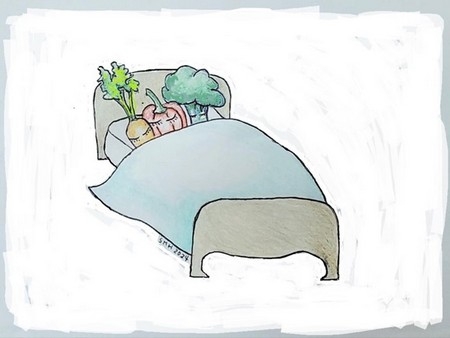
family bed 450



